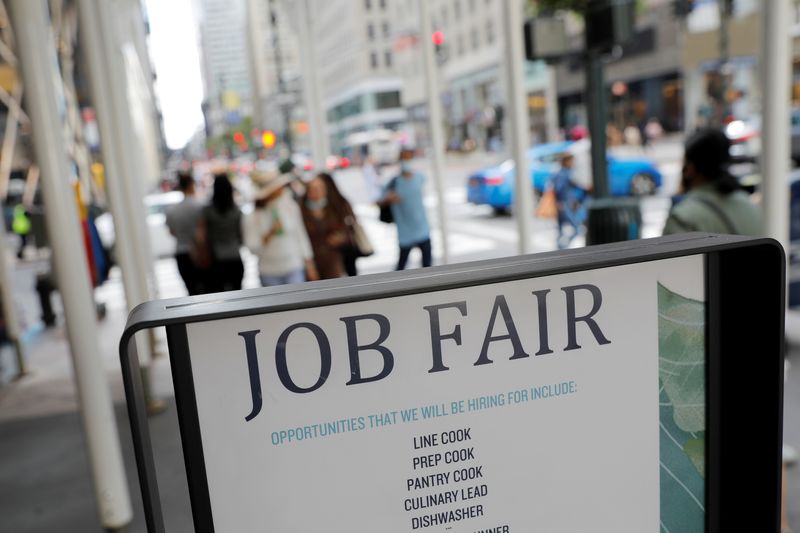By Lucia Mutikani
WASHINGTON (Reuters) -The number of Americans filing new claims for unemployment benefits unexpectedly rose last week and there are growing signs that demand for labor is cooling, with layoffs surging to a 16-month high in June as the Federal Reserve's aggressive monetary policy tightening stokes recession fears.
But the weekly jobless claims data from the Labor Department on Thursday was likely distorted by Monday's Independence Day holiday, which resulted in several states, including California, submitting estimates. Nevertheless, the labor market is losing momentum.
"This is what the Fed wants, but it needs to be orderly to avoid an increase in recession risks," said Ryan Sweet, a senior economist at Moody's (NYSE:MCO) Analytics in West Chester, Pennsylvania.
Initial claims for state unemployment benefits increased 4,000 to a seasonally adjusted 235,000 for the week ended July 2, the highest level since January. Economists say claims need to rise above 250,000 on a sustained basis to raise concerns about the labor market's health.
Unadjusted claims increased 11,919 to 219,507 last week. Claims for California, which saw a big jump in applications, were estimated as were those for Connecticut, Kansas, Louisiana, Nebraska, Tennessee and Virginia. There is a chance the claims data will be revised next week.
Economists polled by Reuters had forecast 230,000 applications for the latest week.
Claims have been bouncing around the 230,000 level since the beginning of June, underscoring the labor market's strength even as some companies in the housing and technology sectors have been cutting jobs. Tesla (NASDAQ:TSLA) has laid off hundreds of workers in the United States.
The claims data could become even more volatile in the weeks ahead. Automobile manufacturers typically close assembly plants for annual retooling after the Independence Day holiday, which is anticipated by the seasonal factors, the model that the government uses to strip out seasonal fluctuations from the data. But a global semiconductor shortage has forced manufacturers to adjust their schedules.
This could lead to fewer temporary layoffs and result in lower seasonally adjusted claims.
LABOR DEMAND COOLING
The U.S. central bank in June raised its policy rate by three-quarters of a percentage point, its biggest hike since 1994, as it fights inflation. Another similar-sized rate hike is expected this month. The Fed has increased its benchmark overnight interest rate by 150 basis points since March.
Demand for labor is gradually cooling. The number of people receiving benefits after an initial week of aid jumped 51,000 to 1.375 million during the week ending June 25. That was the largest weekly increase in the so-called continuing claims since November.
Slowing demand for workers was reinforced by a separate report from global outplacement firm Challenger, Gray & Christmas on Thursday showed layoffs announced by U.S.-based employers accelerated 57% to 32,517 in June, the highest since February 2021.
Job cuts increased 39% to 77,515 in the second quarter from the January-March period. But layoffs in the first half of the year were the lowest since 1993.
"Employers are beginning to respond to financial pressures and slowing demand by cutting costs," said Andrew Challenger, senior vice president at Challenger, Gray & Christmas. "While the labor market is still tight, that tightness may begin to ease in the next few months."
Job cuts surged in the automotive, consumer products, entertainment, financial and real estate sectors.
The loss of momentum in the labor market could be confirmed when the government publishes its closely watched employment report for June on Friday. According to a Reuters survey of economists, nonfarm payrolls likely increased by 268,000 jobs last month after rising by 390,000 in May.
Amidst the anxiety about the economy, there was some good news on the international trade front. A report from the Commerce Department showed the trade deficit narrowed 1.3% to $85.5 billion in May as exports increased 1.2% to a record high. Imports gained 0.6%. The shrinking trade deficit could help avoid another quarterly contraction in gross domestic product.

Second-quarter GDP estimates range from as low as a 2.1% annualized rate of decline to as high as a 1.9% pace of growth.
A record trade deficit weighed on the economy in the first quarter, resulting in GDP declining at a 1.6% rate. Trade has subtracted from GDP for seven straight quarters.